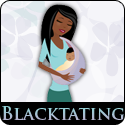I am frequently asked why black women's breastfeeding rates are consistently lower than every other ethnicity's and what we can do to correct this problem. Of course if I had the answer to that question, you'd already know it because you'd be seeing me at conferences the world over, selling my book and my exclusive "Black Breastfeeding Boot Camp" program. Honestly, when I think about this question, lots of things come to mind, like lack of support from family and friends, ignorance about the benefits of breastfeeding, the way black women's bodies have been hypersexualized, the desire from poor people of color to appear to be middle class, etc. But what I bemoan with the most frequency is the lack of images of black breastfeeding. When was the last time you saw a black woman breastfeeding in real life? When was the last time you saw a black woman on the cover of a breastfeeding book? When was the last time you saw a black woman used in advertising to sell a breastfeeding product? While there are some images out there (mainly created by government agencies who are actively seeking to increase black breastfeeding rates) for the most part, black breastfeeding is rarely seen.
In addition to the lack of visibility, we also have the formula companies who aggressively market to women of color. Of course all formula marketing is pretty aggressive but women of color are often disproportionately marketed to already if they are enrolled in WIC. So on top of that, we've also got the images that the formula companies use on their websites and in their magazine ads, which also disproportionately feature women of color.
Take a look at Nestle's Baby Milk website. The first thing you see are two images of women of color, a mom who appears to be black and another who is Asian. When you get to the main content page all you see is black women and babies. I literally had to rub my eyes to figure out if it was the same model over and over again, but nope, that is several different black women and babies. The only white person on the page is the doctor.
In the last year many people have contacted me saying that they want to use images of black women breastfeeding for their books or websites or magazines, but they can't find any pictures to use. This is a head scratcher to me. I know many black breastfeeding moms on Twitter and Facebook. Were they contacted? Best for Babes managed to find a gorgeous black woman to pose in an ad campaign for them. Why can't everyone else?
So while I appreciate that breastfeeding advocates care about increasing breastfeeding rates in the black community, I think we need to concentrate on putting out more images of women of color nursing. Black women need to see themselves in this movement. They need to believe that breastfeeding is just as much for them as it is for white women. How can they do that if black breastfeeding is invisible?
Never want to miss an update of the Blacktating Blog? Subscribe here. Follow me on Twitter- I'm @Blacktating






